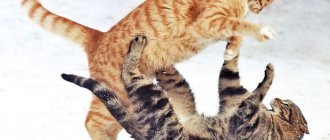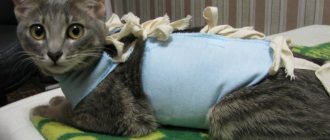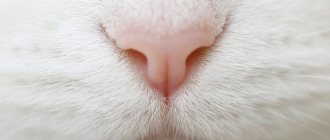What are they afraid of?
Why does such a problem appear before the birth of a child: cats and newborn children. There are several reasons
:
- possible allergy to cat fur; according to statistics, this pathology occurs quite rarely, but if such a situation arises, the animal can always be isolated;
- a cat can become a spreader of infection, but only if it lives both at home and outside.
The last one is very significant. There is a common belief that cats should be allowed outside. But this is not so, because this is a domestic animal for which the territory that it controls is important, in this case, this is the area of the apartment or house. Side factors that encourage a cat to go outside can easily be overcome: by sterilization, at least of the cat, and drug intervention (sedative drops) for the cat.
This procedure is completely painless for a cat, and for a person’s conscience it is absolutely calm, since, having taken an animal to live in a house, we are obliged to fulfill some formalities, otherwise it is better not to take responsibility for the animal.
If we can’t arrange a cat’s life, then why are we trying to have a child? Communication between a cat and a newborn is inevitable after the baby appears in the house. These creatures are very curious, and having become members of the family, they are also jealous, so you need to prepare your pet for the arrival of a new resident of the house.
This is interesting: What to give a cat for vomiting
What will a cat do when a baby appears in the house?
Don’t listen to anyone, if you have a pet and are expecting a baby, don’t rush to part with your pet. Perhaps the baby will not have any allergies to cats, and the pet will happily meet the baby. Their friendship will benefit both the child and the cat. Scientists have proven that communication with pets has a positive effect on the development of children; they learn kindness, care, attention, responsibility; they are also more intellectually developed and adapt well.
If there are a lot of cats
Of course, many people purposefully have cats at home, most often buying famous breeds for divorce. But many simply pick up kittens thrown away by someone or even adult cats that, by the will of fate, ended up on the street. As a rule, this entire flock gets along peacefully with each other.
And he perceives a person as an external strong animal that feeds, cares and caresses. The appearance of a new living creature, which is not much smaller in size than the cats themselves, raises almost no questions for them; on the contrary, animals must immediately be taught not to do the following:
- do not jump into the crib, stroller, table where the baby is swaddled;
- do not interfere with the owners during feeding;
- train the cat not to enter the room where the child is.
It is quite possible to establish this relationship between cats and cats, since this animal is smart and understands its place in the house. Having become accustomed to these basic rules, cats react completely calmly to newborn children.
Cats and children: which breed to choose
Each breed of cat has its own characteristics, pronounced character traits, and disposition. A kitten can be jealous and absolutely neutral to betrayal, affectionate and aggressive, trusting and cautious. Here are some rules for choosing a breed:
- When choosing a kitten, stay around for a while before purchasing and observe its behavior. It's worth getting someone who is calm, affectionate and friendly. The ideal option is one that suits you to meet yourself. Even small cats and children feel each other quite well.
- Don't buy a shy kitten. The house where the child will be will almost always be noisy. This is stress for the animal and unnecessary fears for you.
- At 2 months, the kitten should be playful, curious, and active. And this should not manifest itself in hissing, scratching, biting.
- It is important to have a healthy kitten. Signs: shiny thick coat, no bald spots, even white teeth, clean ears, clear eyes.
Possible risks
First of all, you should take care of the baby’s safety, because even domestic cats can harm a fragile body. Animals often cause the development of the following diseases:
- allergy;
- lichen;
- felinosis;
- helminthiasis;
- toxoplasmosis.
The most dangerous is the latter disease, because a woman can “catch” it from a cat even during pregnancy. The consequences of the disease are very sad: from pathological abnormalities in fetal development to miscarriage. Therefore, it is recommended that the animal be examined by a veterinarian before the child is conceived.
If the pet turns out to be sick, it should be treated, and then, in order to prevent the disease, you need to carefully monitor its hygiene, let it go outside as little as possible, do not feed it raw meat, and also regularly and diligently clean its tray.
As for other ailments, it is not difficult to get rid of them; you just need to give the cat the necessary medications in a timely manner, get vaccinated, monitor its hygiene and visit a veterinarian for an examination.
To prevent fleas, it is recommended to purchase a special collar, regularly bathe your pet and treat its skin with antiparasitic agents.
Some experts argue that a pet can behave unpredictably during periods of hormonal surges, so many advise spaying or neutering it. But if you would like your cat to have offspring in the future, then during adaptation and getting used to the newborn, you can regulate its condition with the help of special medications. In other words, you need to give the animal hormonal medications on a regular basis to prevent the onset of estrus.
Security measures
At the same time, it is necessary to observe some precautions related, first of all, to keeping a cat and compliance with certain sanitary standards and other rules that will allow the animal and the child to coexist peacefully
.
- You need to get all the necessary vaccinations for your animal.
- Be sure to treat against helmites, even if they do not appear.
- Rid your cat of fleas (at home this is quite possible).
- It is necessary to trim your cat's nails regularly.
- Make sure that the newborn and the cat are not left alone.
- Train your cat not to enter the child's room; if the animal feels danger, it will not enter on its own.
- It is also important that the child has completely limited access to the tray and feeding area. Feed the cat in another room so that there is no contact with the newborn.
It is imperative to teach your child that after he has picked up a cat or stroked it, he must wash his hands, even if it is a completely domestic animal. We must remember that there are no completely sterile places in the house, but the cat walks and lies everywhere.
From a very early age, a child must be taught to be caring and affectionate towards animals. A cat can offend a small child only if he himself constantly shows aggression towards her. Therefore, from an early age it is necessary to accustom the child to
:
- perceived a cat not as a toy, but as a living being with a soul and requiring respectful treatment;
- did not allow any manifestations of aggression towards the animal;
- did not mock the cat, did not cause her pain or insult.
Any aggression against a person on the part of a cat is a defensive reaction to the external manifestation of aggression on the part of a person. And even when it manifests itself, it is limited in nature, i.e. the cat may scratch or hiss, warning that it should not be angered further. But these are extreme measures taken by the animal. Usually, when there is a threat, a cat tries to avoid conflict and would rather hide somewhere or run away.
VETERINARIAN CONSULTATION REQUIRED. INFORMATION FOR INFORMATION ONLY.
“If there is a newborn child in the house, then there should be no pets” is a very popular misconception among young parents. Indeed, cats can spread many infections, including toxoplasmosis, but a healthy, well-groomed cat that does not eat raw meat, does not catch mice and is constantly in the house is unlikely to become a source of this disease. Therefore, such views are unfounded and indicate a lack of awareness among parents.
Cat and grown up child
As soon as your baby begins to crawl, the cat is in danger rather than him. This turns out to be a double-edged sword: the child pulls the pet’s tail, and the pet responds with its claws. To prevent this situation from happening, instruct your child in advance to have a humane attitude towards animals. Tell him that the cat is not a toy, it can be painful. You still shouldn't leave your two pets alone.
Under no circumstances should the cat and baby play with the same toys until the other one stops putting everything in his mouth. Be careful in showing your child’s curiosity about the cat’s litter box, food bowl, or genitals. To do this, you can make a hole in the door of the toilet (or the room where the tray is located) through which a cat can fit, but a child cannot fit through. Bowls should only be filled at certain times and any remaining food should be removed or thrown away. Don't forget about trimming your pet's nails.
Preparing the cat and home
Before a newborn baby appears in the apartment, it is necessary to properly prepare the cat. If there were no children before and the pet received all the attention and affection of the owners, then you should gradually reduce the time spent together and teach her to be independent . To prevent her from feeling deprived and resentful, it is recommended to buy her new toys and do not forget to pamper her with her favorite treats. In addition, you can get a second cat.
So that the appearance of a child in the house does not come as a surprise to the animal and does not cause negative reactions, a number of recommendations should be followed.
- Invite people you know with small children to visit. By contacting them, the pet will gradually get used to babies, sharp sounds and increased attention from them. Of course, you need to make sure that the kids do not offend the cat, otherwise in the future it may react negatively to all the little ones.
- Set up a room or corner for the newborn in advance . Let the animal sniff new objects and get used to their smell. It is important to ensure that the cat does not lie down on children's things and does not jump into the crib. Such attempts must be stopped immediately, but without aggression or shouting.
- A cat may become jealous of a child if she is not given enough attention, so there is no need to push her away when she asks for affection. In addition, you should ask the same thing to guests who will come to visit you and the baby.
- Introducing a pet to a newborn should take place in a calm environment. Let him sniff the baby and the things brought: diapers, bottles, pacifiers, powder, etc. It is advisable to feed the animal and the baby before meeting them so that they are both calm and relaxed. Otherwise, the child's crying and sudden movements may frighten the cat and cause aggression.
- At first, you should not leave the animal and the newborn alone - you must definitely look after them. At the same time, you should not prevent the cat from showing interest in the child. She can rub against him, lie next to him and even lick him. Such gestures should be regarded as caring and are recommended to be encouraged. But you should remember that it is better not to allow your pet to lick the face of a newborn, as this may be unsafe.
As the child grows up, you need to teach him how to handle it correctly.
While playing, a baby may inadvertently touch a pet, throw a toy, or make a loud, sharp sound. At such moments, you need to be there and show the animal that it should not be afraid. Over time, your pet will get used to this and will not react sharply to unexpected or unpleasant sounds.
It is believed that families with pets produce more sensitive and merciful children. From the first days of life, they learn to love and care for those who are smaller and weaker. When planning a new addition to the family, you shouldn’t think that a cat can harm the baby, and certainly don’t need to get rid of it. It is enough to properly and timely prepare the animal for the arrival of a new family member, and all problems will disappear by themselves.
This is interesting: Causes of dandruff on a cat's back
Preparation
Cats are quite tolerant of newborn children if you prepare them in advance for the arrival of a new member of the community that lives in this house or apartment. To do this, you need to take the following preventive measures :
- for a cat, one of the main stresses is noise, which is inevitably associated with the appearance of a newborn baby in the house, so you need to accustom the animal in advance to these loud sounds that a baby makes when inviting friends who have small children home;
- accustom your pet to the sounds of a rattle, give the opportunity to smell those substances and objects that will be associated with the child: powder, baby cream, lotion, shampoo, cats receive almost half of the information through smell;
- You need to talk with your pet about future changes, naming the name of the future child, if it has already been chosen.
For a pet, the appearance of a new family member, especially one of such small size, will always be a surprise to which he needs to get used to.
© shutterstock
Can't be allowed, can't be refused
There are situations when there is no way to adopt or buy a pet for a family:
- rental apartment;
- an allergy to wool in a child or one of the family members;
- lack of time for parents, workload.
- Does a young family live in a small or rented apartment? You can buy not a big dog, but a tiny hamster or guinea pig. The baby will laugh and watch as the hamster stuffs all the food into its cheeks. At this point, it would be appropriate to remind the child that a person should not do this. Small pets allow a child to feel big and kind, a real protector. He will not be able to experience such a feeling if he is only around adults or a large dog.
- Are you allergic to wool? Then it’s best to buy your baby some fish. These pets don’t take up much time, you don’t need to walk them, and they don’t eat much. The only negative is that the baby will not be as interested in them as with those whom he can touch and cuddle, with whom he can run and tumble.
- Birds such as canaries and parrots will also not take up much space. They are beautiful and sing wonderfully. Children develop an aesthetic taste and a craving for beauty from interacting with birds. One warning: it is very rare, but allergies to bird plumage and droppings can occur.
- It is not necessary to buy your child a purebred Rex or a Siamese Bella. Outbred animals, not so refined and pampered, combine all the best qualities: responsiveness, kindness, devotion, gratitude. They don't demand anything, they just love with all their souls. The baby next to them grows up loyal, responsive, capable of gratitude, and able to love.
- Rodents take up little space, so everyone can afford to buy them for their apartment. Hamsters bring more aesthetic pleasure. It’s impossible to take your eyes off the fluffy ball, happily running around the room and pushing food into its cheeks. Rabbits and chinchilla guinea pigs are also unlikely to become bosom buddies for a child. But rats are distinguished by their attachment to humans. They become real friends. Sometimes rats, sitting on a child’s shoulder, make excursions outside, of course, if the mother allows it. And they don’t run away anywhere.
We suggest you familiarize yourself with How to clean a cat’s ears at home: options for how to rinse and with what
It's about safety. Young parents need to know that when they buy a pet, they add another full member to the family. This is not a toy. Not a momentary whim for a child. You become responsible for another life.
- It is unacceptable to adopt a puppy or kitten and then simply give it to friends because the baby’s interest in them has decreased. By such an act, you not only show cruelty, but also program your child’s behavioral matrix. If cruelty is the norm for parents, then what can you expect from your child in the future?
- Choosing a pet for a family is a serious matter. Who should you give preference to: a puppy or a kitten, a bird or a fish, a guinea pig or a hamster? A matter of taste, but not only;
- It is dangerous to bring a fighting breed dog into your home. Playing with children is completely out of character for these dogs. It is necessary to learn more about the characteristics of dog breeds and their behavioral characteristics in advance.
- When buying an animal, ask to see a certificate from a veterinarian. This is not just a piece of paper with a stamp, but the safety of your family. Often a dog or cat is picked up without any interest in the health of the animal, including its mental health. Who can guarantee that a cat or dog will not attack a child? Remember that vaccinations are not a whim of doctors. An infection or disease may enter your home along with a sick animal;
- Exotic animals occupy a special place. They can only be purchased at a pet store. Under no circumstances buy canaries and parrots from dubious bird markets based on advertisements. Very often they are brought in illegally, and in most cases the birds are carriers of rare diseases;
- Mom must patiently explain to her child that he is big, and the bird or hamster is small, they cannot be hugged “tightly”, like dad, otherwise you can accidentally strangle him. Behavioral taboos are established.
- It is necessary to constantly monitor the health of the animal. Infecting a dog or cat with fleas and worms is unacceptable. This is very dangerous for the child, he can become infected and become seriously ill.
We invite you to read: What do ferrets eat and how to feed them?
Fishes for children
- the cockerel is a very beautiful fish that does not require serious care, large space and constant aeration of the water, which is important if the aquarium is in a child’s bedroom;
- guppy is an unpretentious fish, very easy to care for, which does not need a large aquarium;
- Barbs are attractive, easy to care for, active fish;
- Neons are small schooling fish, nimble and interesting to watch;
- Diamond cichlazomas are a large, beautiful fish that swims slowly and steadily, but is somewhat aggressive;
- goldfish are unpretentious, colorful fish that are interesting to watch.
What to do when a newborn appears in the house with a cat?
The animal does not view the baby as a troublemaker and competitor, as would happen if we brought another member of the feline family into the house. However, having a newborn cat can cause some stress. However, it is associated not so much with the presence of a child, but with the hustle and bustle that usually accompanies his appearance in the family. Can cats be jealous of a small child? And how! However, we can help the pet get used to the new situation faster.
- First of all, we do not need to immediately and completely isolate the animal from the child. This way it will be convinced that this crying lump is just a small person who does not pose any threat to it. In addition, the crying of a newborn can awaken the cat's protective instinct, because this is a danger signal. In this case, the pet will try to hurry up with help, as he would do in the case of his own offspring. In such a situation, the obstacle of closed doors will cause him additional stress and anxiety.
- When the child arrives home, give the cat the opportunity to smell and even touch him, if he has such a desire. The reaction of animals to a new family member, of course, greatly depends on their temperament. Some cats initially keep a short distance, others immediately occupy the crib. But surely they will all be interested in the newcomer, because feline curiosity is a proverb! However, no matter how lively the cat’s interest in the newborn baby may be, it is better to carefully suppress it and not allow her to have physical contact with him. A cat has no place in a child's bed.
- Although your attention is absorbed by the offspring, always remember that the cat was until now the favorite of the whole family, and now suddenly finds itself relegated to the background. He is not human, and it is difficult for him to understand why he was suddenly expelled and not allowed to enter the room where the child now sleeps. And the more he was spoiled before, the worse it is for him to endure the new situation. Therefore, continue to show the animal the same sympathy, show interest in it and spend some time. Let it be present during everyday child care, sitting somewhere in a corner, watching your manipulations. If you find time to pet the cat and say kind words to it, it will have no reason to envy and jealousy of the child (just don’t forget after such contacts wash your hands). The relationship between a happy animal and the baby will be positive. And after a while you will be able to see that cats and small children can become good friends.
It is unlikely that you will get a kitten when you have a newborn in the house. But it often happens that a cat is already present in the house when the family is preparing for the arrival of the baby. Even during pregnancy, the expectant mother begins to be frightened by the fact that the animal has no place next to the baby, that its fur can cause an allergic reaction in the child, and the cat itself is a carrier of almost all existing diseases. Is it so dangerous to have a pet in your apartment that you have to part with a family member?
The cat and the small child are not the hunter and the prey
Can a cat harm a baby?
For many parents this is a matter of particular concern. Therefore, when a baby appears in the house, the animal is isolated, or - even worse! - they get rid of him. Neither the first, nor even the second can be called a good solution, because a cat and a newborn can get along wonderfully under one roof. The main thing is to behave correctly and take precautions. How can four-legged pets harm a small child? Can cats choke children? Is this true? Horror stories about cats killing innocent babies are an echo of medieval superstitions, in which they appeared as a tool in the hands of the devil. In addition, this is reflected in a complete lack of understanding of cat nature. There is absolutely no reason for cats to attack a child. Yes, they are predators, but this does not mean that they can recognize a baby as prey. Cats hunt small birds and rodents, and newborn babies are not at all like them.
The kids do not look so formidable that cats could attack them in self-defense. On the contrary, the baby, rather, awakens the instinct of care and patronage than gives rise to aggression. Everything indicates that the cat feels that she is dealing with a young representative of the human race, and behaves very carefully towards him. This is not so surprising, since a small kitten and a newborn have similar proportions, move awkwardly and make similar “meowing” sounds. All mammalian babies stimulate the initiation of protective instincts. Stories of children raised by animals are not legends, but documented facts.
Another thing is that some pets do things that their owners obviously won’t like - for example, cats can hiss at newborns, sleep with them in a warm crib or stroller, and constantly hang around. However, all this does not indicate aggression - rather, a defensive position or a manifestation of interest, or even sympathy, with a tiny creature.
Cats in a home with small children can only be dangerous because they are carriers of various diseases.
However, the likelihood that a child will become infected with something from an animal that does not leave the house and is under the constant supervision of veterinarians is reduced to almost zero. We are more likely to bring some microbes into the house ourselves than a cat that has little contact with the outside world. Therefore, if she does not leave the house, there is no need to worry about the child’s health. But if your cat walks on its own, then you should limit its contact with the newborn, take more care of hygiene and find room in your busy schedule for visits to the veterinarian.
What diseases can a cat give to a child?
Infection occurs from the primary host.
There are the following routes of human infection:
Manifestations
Toxoplasmosis can occur in acute, subacute, chronic, subclinical, inpatient (lack of symptoms and development of immunity) forms, as well as in the form of carriage.
In the vast majority of cases, this disease is asymptomatic in people with a normal immune response.
In the acute course of the disease, headache, weakness, fever, enlargement of lymph nodes, liver, and spleen are possible. Less commonly, a roseolous-papular rash (in the form of nodules and inflammatory spots) may occur.
As a rule, all adult cats that have been outside and eaten raw meat or mice have already had toxoplasmosis. A danger to a child is a primarily infected animal that has just become ill. And this is usually a kitten.
Toxoplasmosis is very dangerous for pregnant women. It can cause pregnancy failure and fetal death in the womb.
Also, due to severe damage to the nervous system, eyes, heart and other organs, newborn babies with congenital toxoplasmosis often die in the first day of life.
If a child infected in the womb survives, then in 100% of cases he is disabled with severe damage to the nervous system and paresis.
Due to the enormous danger of the disease, pregnant women undergo immunological tests when registering - serological reactions with determination of the titer of immunoglobulins of class G and M (IgM and IgG).
Class M immunoglobulins are produced during a fresh infection (that is, a person is currently infected with Toxoplasma). Class M immunoglobulins are detected in the blood two weeks after infection.
The lifespan of IgM is about six months. If there is no IgG, then such a woman does not have immunity from toxoplasmosis. And that means it needs treatment and careful monitoring.
IgG indicates a previous illness. That is, if IgG is detected in a pregnant woman, this means that the pregnant woman had contact with Toxoplasma in the past. Class G immunoglobulins provide long-lasting, stable immunity, which guarantees protection against recurrence of the disease.
As I already said, the diagnosis of toxoplasmosis consists of carrying out serological reactions (enzyme immunoassay or immunofluorescence reaction). In this case, the blood is examined.
Blood sampling is carried out twice, with an interval of 2-3 weeks. This allows you to determine the increase in IgM and IgG titers.
Other methods for detecting toxoplasmosis:
- Tests with toxoplasmin. A positive result indicates a previous or chronic course of toxoplozosis.
- Ultrasound of internal organs. Allows you to detect enlargement of the liver, spleen, lymph nodes.
Lichen
Feline lichen in a child is a rather serious contagious fungal disease, manifested by small spots with clear boundaries.
Most often, lichen is carried by small kittens with weak immune systems. Thanks to such carriers, this type of fungus is popularly called cat lichen. The same disease may be referred to in medical literature under a different name – ringworm.
Fungal diseases can be transmitted to humans directly from a sick animal or through contaminated objects. Of course, when precautions are not followed.
Ringworm can affect any part of the body, but is most often localized on the neck, face, back, and forearm.
Feline ringworm appears as pink spots with clear boundaries. Often the border of the element is presented in the form of bubbles. The spots quickly increase in size and tend to merge if there are several of them. Characterized by itchy skin and peeling of the skin in the affected area.
When the scalp is affected, the hair in the lesions breaks off at a level of 0.5 cm from the base. Hence the name of the disease - ringworm. The affected area takes on the appearance of a shaved area of the head.
It is better for a person to start treatment after laboratory testing by a dermatologist.
Treatment of this disease is complex. Usually includes cutting the hair adjacent to the affected area, antifungal agents (topically and for oral administration), and restorative drugs (immunomodulators).
Cat scratch disease
This is an infectious disease that develops after being scratched or bitten by an infected cat. Felinosis, benign lymphoreticulosis, Mollaret granuloma, cat scratch disease - these are all names of the same disease.
The main causative agent of felinosis is the bacterium Bartonella henselae.
The main reservoir of infection is infected cats. The bacterium practically does not cause any pathological conditions in animals. But its toxins are dangerous for humans. Children and young people suffer from this disease more often.
The bacillus, getting on the skin at the site of a scratch or bite, subsequently enters the bloodstream. In this case, a primary inflammatory focus (suppuration in the form of an abscess) is formed at the site of damage. This is the result of the production of toxins by the microbe at the site of injury. The child’s condition at this stage does not suffer.
Then the pathogen enters the lymph nodes located closest to the gate of infection through the lymph flow. An inflammatory process develops there. Lymph nodes increase in size, become denser and painful. Most often this occurs with elevated temperature.
When the pathogen enters the bloodstream, the infection affects many target organs. The lymph nodes, spleen and liver become enlarged, and skin rashes appear. The heart muscle may be affected and the disease myocarditis develops.
All this is accompanied by weakness, general malaise, loss of appetite, sweating, and rapid heartbeat.
Often the affected lymph nodes suppurate. Also, not only regional lymph nodes, but also distant groups of lymph nodes can be involved in the process.
Typically, diagnosing this disease is not difficult. It is easy to notice with the naked eye. Parents themselves are able to notice inflammation at the site of the cat scratch and subsequent enlargement of the nearest lymph node.
In most cases, this disease heals spontaneously. But it happens that it is impossible to do without intervention from doctors.
Antibacterial therapy is prescribed. In case of severe lymphadenitis, anti-inflammatory treatment using non-steroidal anti-inflammatory drugs is prescribed.
Helminthiasis
A child can become infected with some helminths (worms) from cats. I won’t go into detail on this. Just keep in mind that you need to monitor the cat’s health, and children who have contact with cats need to regularly prevent helminthic diseases.











